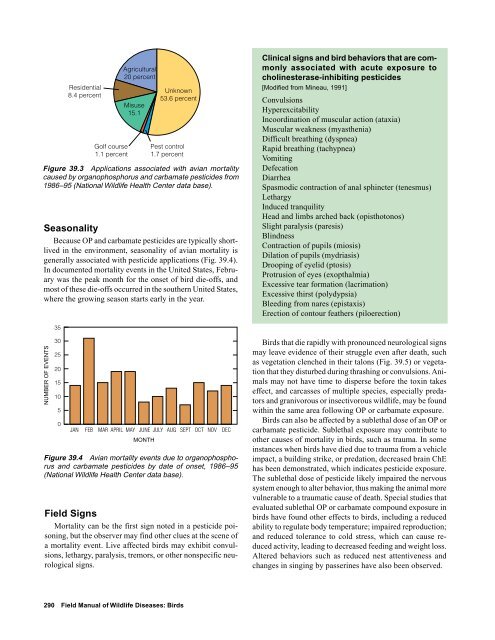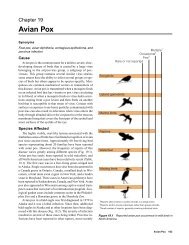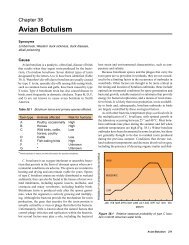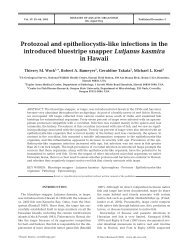Organophosphorus and carbamate pesticides - National Wildlife ...
Organophosphorus and carbamate pesticides - National Wildlife ...
Organophosphorus and carbamate pesticides - National Wildlife ...
Create successful ePaper yourself
Turn your PDF publications into a flip-book with our unique Google optimized e-Paper software.
Residential<br />
8.4 percent<br />
Golf course<br />
1.1 percent<br />
Agricultural<br />
20 percent<br />
Misuse<br />
15.1<br />
Unknown<br />
53.6 percent<br />
Pest control<br />
1.7 percent<br />
Figure 39.3 Applications associated with avian mortality<br />
caused by organophosphorus <strong>and</strong> <strong>carbamate</strong> <strong>pesticides</strong> from<br />
1986–95 (<strong>National</strong> <strong>Wildlife</strong> Health Center data base).<br />
Seasonality<br />
Because OP <strong>and</strong> <strong>carbamate</strong> <strong>pesticides</strong> are typically shortlived<br />
in the environment, seasonality of avian mortality is<br />
generally associated with pesticide applications (Fig. 39.4).<br />
In documented mortality events in the United States, February<br />
was the peak month for the onset of bird die-offs, <strong>and</strong><br />
most of these die-offs occurred in the southern United States,<br />
where the growing season starts early in the year.<br />
Clinical signs <strong>and</strong> bird behaviors that are commonly<br />
associated with acute exposure to<br />
cholinesterase-inhibiting <strong>pesticides</strong><br />
[Modified from Mineau, 1991]<br />
Convulsions<br />
Hyperexcitability<br />
Incoordination of muscular action (ataxia)<br />
Muscular weakness (myasthenia)<br />
Difficult breathing (dyspnea)<br />
Rapid breathing (tachypnea)<br />
Vomiting<br />
Defecation<br />
Diarrhea<br />
Spasmodic contraction of anal sphincter (tenesmus)<br />
Lethargy<br />
Induced tranquility<br />
Head <strong>and</strong> limbs arched back (opisthotonos)<br />
Slight paralysis (paresis)<br />
Blindness<br />
Contraction of pupils (miosis)<br />
Dilation of pupils (mydriasis)<br />
Drooping of eyelid (ptosis)<br />
Protrusion of eyes (exopthalmia)<br />
Excessive tear formation (lacrimation)<br />
Excessive thirst (polydypsia)<br />
Bleeding from nares (epistaxis)<br />
Erection of contour feathers (piloerection)<br />
35<br />
NUMBER OF EVENTS<br />
30<br />
25<br />
20<br />
15<br />
10<br />
5<br />
0<br />
JAN FEB MAR APRIL MAY JUNE JULY AUG SEPT OCT NOV DEC<br />
MONTH<br />
Figure 39.4 Avian mortality events due to organophosphorus<br />
<strong>and</strong> <strong>carbamate</strong> <strong>pesticides</strong> by date of onset, 1986–95<br />
(<strong>National</strong> <strong>Wildlife</strong> Health Center data base).<br />
Field Signs<br />
Mortality can be the first sign noted in a pesticide poisoning,<br />
but the observer may find other clues at the scene of<br />
a mortality event. Live affected birds may exhibit convulsions,<br />
lethargy, paralysis, tremors, or other nonspecific neurological<br />
signs.<br />
Birds that die rapidly with pronounced neurological signs<br />
may leave evidence of their struggle even after death, such<br />
as vegetation clenched in their talons (Fig. 39.5) or vegetation<br />
that they disturbed during thrashing or convulsions. Animals<br />
may not have time to disperse before the toxin takes<br />
effect, <strong>and</strong> carcasses of multiple species, especially predators<br />
<strong>and</strong> granivorous or insectivorous wildlife, may be found<br />
within the same area following OP or <strong>carbamate</strong> exposure.<br />
Birds can also be affected by a sublethal dose of an OP or<br />
<strong>carbamate</strong> pesticide. Sublethal exposure may contribute to<br />
other causes of mortality in birds, such as trauma. In some<br />
instances when birds have died due to trauma from a vehicle<br />
impact, a building strike, or predation, decreased brain ChE<br />
has been demonstrated, which indicates pesticide exposure.<br />
The sublethal dose of pesticide likely impaired the nervous<br />
system enough to alter behavior, thus making the animal more<br />
vulnerable to a traumatic cause of death. Special studies that<br />
evaluated sublethal OP or <strong>carbamate</strong> compound exposure in<br />
birds have found other effects to birds, including a reduced<br />
ability to regulate body temperature; impaired reproduction;<br />
<strong>and</strong> reduced tolerance to cold stress, which can cause reduced<br />
activity, leading to decreased feeding <strong>and</strong> weight loss.<br />
Altered behaviors such as reduced nest attentiveness <strong>and</strong><br />
changes in singing by passerines have also been observed.<br />
290 Field Manual of <strong>Wildlife</strong> Diseases: Birds
















